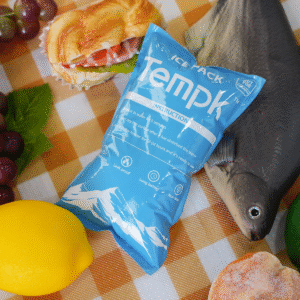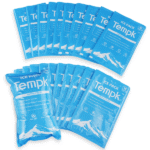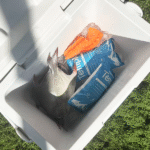Aktualisiert: August 13, 2025. Wenn Sie verwenden dry ice packs for shipping chocolate, this guide shows how to keep product firm, glossy, and compliant—without freezing it. You’ll learn a hybrid packout that buffers the product at 15–18 °C, the right dry‑ice amount for 24–72 h lanes, und die 2025 acceptance rules that stop rejections at tender. (This guide consolidates and elevates your three drafts.)
-
When to use dry ice packs for shipping chocolate on hot lanes without causing bloom
-
How to pack and label a compliant hybrid shipper (Schritt für Schritt)
-
Wie viel Trockeneis you actually need for 24–72 h routes (Schneller Schätzer)
-
Which coolant to choose—dry ice vs gel vs 15–25 °C PCM—for your lane
-
Was hat sich verändert 2025 (IATA -Checkliste, USPS clarity, new chocolate research)
When should you use dry ice packs for shipping chocolate?
Use a hybrid approach—gel or 15–20 °C PCM around the chocolate, plus a small dry‑ice layer on top—to add headroom against heat without freezing. Carriers themselves advise gel packs for “cold” and dry ice for “frozen,” so a hybrid protects chocolate quality while avoiding brittle texture.
Warum funktioniert es: Dry ice absorbs a lot of heat as it sublimes (~571 kJ/kg, per NIST), so a small amount keeps your gels effective through the hottest part of day 1, while the PCM/gel maintains a gentle “cool” micro‑climate around the bars.
Hybrid packout with 15–20 °C PCM—when does it help?
PCMs targeted at 15–25 °C are common now and qualified to ISTA thermal profiles. They buffer temperature swings that cause sugar/fat bloom and reduce over‑cooling risk next to dry ice. Choose solutions qualified against ISTA 7E/7D profiles for realistic hot/cold cycles.
| Coolant choice | Am besten für | Faustregel | Was es für Sie bedeutet |
|---|---|---|---|
| Gelpackungen (0 ° C PCM) | Halten Cool, nicht gefroren | Size gels to payload; overnight lanes | Lowest bloom risk; simple compliance. |
| Trockeneis (Und 1845) | Extreme heat / gefroren | Hinzufügen small top layer; Entlüftung & Etikett | Big heat headroom; requires Class 9 label + Und 1845. |
| 15–25 °C PCM | Stable room‑temp band | Belt around product | Dampens spikes, protects gloss & snap. |
Praktische Tipps, die Sie heute verwenden können
-
Ship Mon–Wed to avoid weekend holds; many chocolatiers do exactly this.
-
Right‑size the shipper to reduce void space; reflective liners help on 24–48 h lanes.
-
Keep RH low and avoid cold‑shock to prevent bloom; target 12–18 °C and <50–60% RH.
Wirklicher Fall: Moving to a hybrid (15 °C PCM belt + small top dry‑ice layer) and Mon–Wed dispatch cut summer melt claims sharply on a 34 °C lane, keeping in‑transit temps 14–18 °C.
How many dry ice packs for shipping chocolate do you need?
Kurze Antwort: Start small—5–15% of payload weight in Trockeneis on top only, separated by a rigid barrier. Let gels/PCM do the main work while dry ice covers ambient spikes. Increase +5% für >35 °C lanes; reduce −5% for mild routes.
Warum funktioniert das: Dry ice has very high latent heat (~571 kJ/kg) and each pound releases ~250 L of CO₂ gas—powerful cooling, but you must let gas escape.
Quick 24–72 h estimator (kopieren/einfügen)
Use a data logger to validate and tune by ±15–25% on your worst route before scaling.
How to pack dry ice packs for shipping chocolate safely (and compliantly)
Schritt für Schritt:
-
Condition components. Freeze gels; stage PCMs per spec; pre‑cool the shipper.
-
Wrap product, control humidity. Bag chocolate; add light void fill; keep RH low to avoid sugar bloom.
-
Build the “gel/PCM cocoon.” Surround chocolate with gels/15–20 °C PCMs.
-
Insert a rigid barrier. Foam board/card to block the −78.5 °C plume.
-
Add dry ice on top only. Never touch product; Stellen Sie die Entlüftung sicher (49 CFR173.217).
-
Markieren & Etikett. Und 1845, NET Dry -Ice Kg, Class9 Diamant; follow the 2025 IATA ACCEPTION CHECKLISTE (PI954) at tender.
-
Pick service & dispatch. Overnight where possible; Vermeiden Sie das Wochenende.
Dry ice packs for shipping chocolate vs gel packs vs PCM—which is right?
-
Dry ice packs for shipping chocolate: adds powerful heat margin; muss vent and label; aim to prevent freezing, not cause it.
-
Gelpackungen (0 ° C): simplest for “cool” deliveries; carriers recommend them for non‑frozen perishables.
-
15–25 °C PCM: stabilizes quality (gloss, snap) and dampens spikes; now widely available and qualified to ISTA thermal profiles.
Bloom guardrails: Store and ship near 12–18 ° C. bei <50–60% RH to reduce sugar/fat bloom; avoid temperature cycling.
Träger & regulatory rules for dry ice packs for shipping chocolate (2025)
-
Hier ist PI954 (Luft): Und 1845 (Kohlendioxid, solide), Entlüftungsverpackung, markieren Nettogewicht (kg). ≤200 kg/Paket; Verwenden Sie das 2025 Akzeptanz -Checkliste. (Operator variations may be stricter.)
-
USPS (Hausluft): dry ice allowed with Verpackungsanweisung 9A; common limit ≤5lb pro Poststück; prohibited internationally.
-
DOT 49 CFR 173.217 (UNS. Boden): package must permit gas release; Keine luftdichten Behälter.
-
FedEx/UPS practice: correct Class9 Etikett + Und 1845 with net kg; some UPS routes impose lower limits than IATA—confirm.
-
Exposure safety: CO₂ TWA 5,000 ppm; SATZ 30,000 ppm—ship in ventilated spaces; never seal dry ice in confined volumes.
2025 trends in dry ice packs for shipping chocolate
Heat‑resistant chocolate: New peer‑reviewed work shows curing protocols and additives can keep structure at 33–55 °C, but flavor/appearance still benefit from controlled shipping.
Standardized acceptance: Hier ist 2025 Akzeptanz -Checkliste streamlines counter checks for dry‑ice consignments with non‑DG payloads like confections.
PCM adoption: Broader 15–25 °C PCM portfolios and ISTA‑qualified shippers make ambient buffering mainstream for confections.
Operational discipline: More brands ship Mon–Wed und fügen Sie hinzu warm‑weather surcharges to fund gels/liners in hot months.
Häufig gestellte Fragen
Will dry ice ruin chocolate?
Not if you separate Es. Keep a gel/PCM cocoon around the product and place a small dry‑ice layer on top with a rigid spacer; avoid direct contact and cold shock.
How cold should chocolate be in transit?
Aim for 15–18 ° C. (59–65 °F) mit RH <50–60% to protect gloss and snap and reduce bloom.
How much dry ice for 24–48 h?
Fangen Sie an 5–15% of payload weight, then validate with a temp logger and adjust by lane (+/−15–25%).
What labels are required?
Markieren Und 1845 Und net dry‑ice weight (kg) and apply the Class9 Diamant; follow the Iata 2025 Akzeptanz -Checkliste.
Can I mail dry ice with USPS?
Ja für häusliche Luft bis zu 5 lb unter PI 9A; no international mail. Paket muss co₂ entlüften.
Is dry ice hazardous in sealed boxes?
Ja. Each pound can release ~250 L of CO₂; venting is mandatory.
Zusammenfassung & Empfehlungen
Fazit: Dry ice packs for shipping chocolate work best in a Hybrid packout. Let gels/PCMs hold the product zone; Verwenden Sie a small, entlüftet dry‑ice layer on top for heat spikes; label and mark per IATA/USPS/DOT. Schiff schnell, Validieren Sie mit einem Logger, and avoid weekends.
Nächste Schritte (your quick plan):
-
Pilot one hot lane this week with the estimator above and a logger.
-
Switch to Mon–Wed dispatch for summer.
-
Add a 15–20 °C PCM belt to your current dry‑ice packout.
-
Markieren Und 1845 + net kg and keep vent paths open (49 CFR173.217).
Über Tempk
Wir entwerfen einfach, tested packouts for complex lanes. Our engineers blend dry ice, 15–20 °C PCMs, and premium insulation to hit your quality target with fewer claims, and we bring Hier ist PI954 / USPS PI 9A readiness to every project. Book a free lane simulation and we’ll tailor a compliant packout to your routes and budget.
























